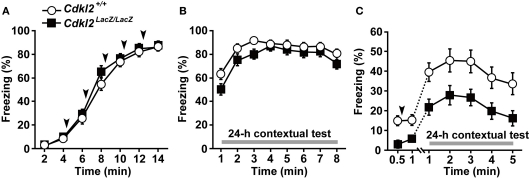Figure 5.
Contextual fear conditioning. Freezing responses were evaluated in two different protocols, (I) and (II). (A) In protocol (I), five footshocks (0.7 mA for 1 s, 2 min apart) were given at 4, 6, 8, 10, and 12 min after the animals were placed in the chamber. Pre-shock baseline freezing (4 min) was not significantly different between Cdkl2+/+ and Cdkl2LacZ/LacZ mice. During conditioning, the percent time spent freezing was determined. Arrowheads indicate when the footshock was administered. (B) In the 24-h contextual test, percent time spent freezing was determined for 8 min. Repeated measures ANOVA revealed no significant main effect of genotype on conditioning (F(1,28) = 0.034, P = 0.8559) or in the 24-h contextual test (F(1,28) = 2.295, P = 0.1410), and there was no significant interaction between genotype and time of conditioning (F(4,112) = 1.626, P = 0.1727) or in the 24-h contextual test (F(7,196) = 1.210, P = 0.2991). There was a significant difference between Cdkl2+/+ and Cdkl2LacZ/LacZ mice in the mean values in minutes 1, 2, and 3 of the 24-h contextual test (F(1,28) = 4.718, P = 0.0385). (C) In protocol (II), a single footshock (0.35 mA for 3 s) was given a 30 s after the animals were placed in the chamber. Pre-shock baseline freezing (30 s) was significantly decreased in Cdkl2LacZ/LacZ mice (t(38) = −2.642, P = 0.0119, unpaired Student's t-test), but post-shock freezing (30 s) was not significantly different (t(38) = −1.868, P = 0.0694). Percentage of time spent freezing on the 24-h contextual test was measured for 5 min immediately after the animals were returned to the footshock chamber. Repeated measures ANOVA revealed a significant main effect of genotype (F(1,38) = 10.743, P = 0.0022) but the interaction between genotype and time was not significant (F(4,152) = 0.003, P > 0.9999).

